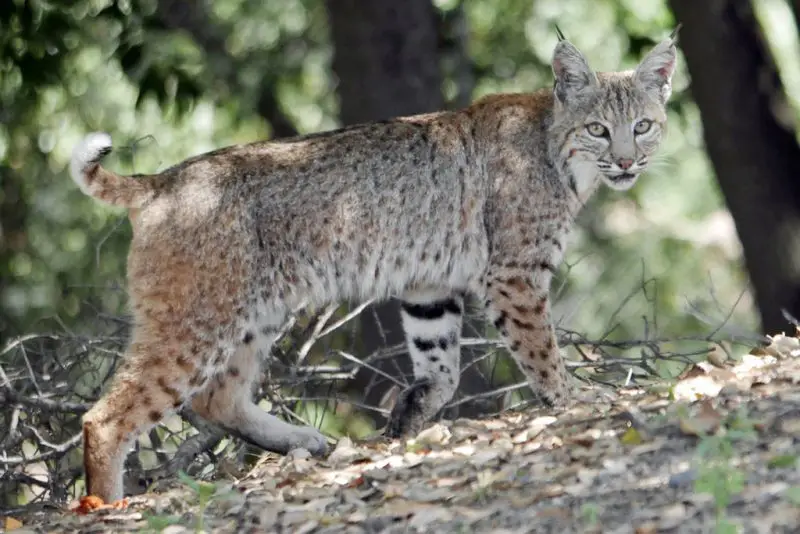Bobcats (Lynx rufus) are among Missouri’s most elusive and captivating predators. These medium-sized wildcats are admired for their agility and striking appearance, moving silently through forests, grasslands, and river valleys. Despite being relatively widespread, encountering a bobcat in the wild remains a rare and memorable experience for nature enthusiasts.
Known for their solitary lifestyle, bobcats rely on stealth and adaptability to survive. They navigate dense woodlands and rugged terrain with remarkable ease, demonstrating hunting skills honed over millennia. Observing their behavior offers a fascinating glimpse into the life of one of Missouri’s top carnivores.
For those curious about these mysterious cats, understanding their physical traits, hunting habits, and preferred habitats is key. This knowledge not only enhances opportunities to spot them but also helps ensure safe and respectful observation, deepening appreciation for these skilled and secretive hunters.
Physical Characteristics of Bobcats in Missouri

Bobcats in Missouri are easily recognized by their distinct features. They possess a short, “bobbed” tail, which gives the species its name, and tufted ears reminiscent of their larger relatives, the lynx. Their fur is a mix of reddish-brown, tan, and gray, patterned with dark spots or streaks, which provides excellent camouflage in woodland and brush environments. The underparts, including the belly and the inner legs, are usually lighter, ranging from cream to white. This color contrast helps them blend seamlessly into their surroundings while stalking prey.
The face of a bobcat is marked by prominent whisker pads and facial ruffs, which contribute to their expressive appearance. They have sharp, almond-shaped eyes with vertical slit pupils that enhance night vision, an essential adaptation for their primarily nocturnal lifestyle. Bobcats also have retractable claws, which aid in climbing, gripping prey, and navigating various terrains across Missouri’s diverse ecosystems.
Size and Weight of Missouri Bobcats
Missouri bobcats exhibit sexual dimorphism, meaning males are generally larger than females. Adult males typically weigh between 20 to 35 pounds, with a body length ranging from 35 to 50 inches, including their short tail. Females are slightly smaller, weighing 15 to 25 pounds and measuring approximately 30 to 45 inches in total length. Despite their moderate size, bobcats are muscular and agile, capable of sudden bursts of speed that make them efficient hunters.
The bobcat’s limbs are powerful and built for pouncing, leaping, and climbing. Their hind legs are slightly longer than the front legs, enabling them to spring upward to ambush prey. Missouri’s diverse terrain, including rocky bluffs and dense forests, allows these strong limbs to be fully utilized. Observing a bobcat’s physical prowess in action is a rare but awe-inspiring experience.
Behavior and Territory
Bobcats are highly territorial animals. In Missouri, each individual maintains a home range that can vary greatly depending on prey availability, habitat quality, and sex. Males tend to occupy larger territories than females, sometimes overlapping with the ranges of multiple females. They communicate using scent markings, scratches on trees, and vocalizations to signal dominance and discourage intrusions. Their secretive nature and preference for dense cover make them difficult to observe, despite being relatively common throughout the state.
These wildcats are predominantly nocturnal, hunting and patrolling their territory under the cover of darkness. However, they can occasionally be seen during daylight, particularly in remote or undisturbed areas. Bobcats are solitary except during the mating season or when a mother is raising kittens. This solitary lifestyle reduces competition for food and minimizes encounters with humans.
Hunting and Diet
Bobcats are skilled predators with a varied diet, adapting their hunting techniques to the prey available in their Missouri habitats. Their diet primarily consists of small mammals, including rabbits, squirrels, mice, and raccoons. They are also known to prey on birds, reptiles, and even insects when food is scarce. Larger prey, such as young deer or domestic poultry, may occasionally be taken, particularly by larger males.
Hunting is typically stealth-based. Bobcats rely on patience, using dense cover to stalk their prey silently before making a sudden, rapid pounce. Their keen sense of sight and hearing allows them to detect movement from a considerable distance, while their sharp teeth and powerful jaws ensure a swift kill. Missouri’s mix of forests, fields, and wetlands provides abundant hunting grounds, allowing bobcats to maintain a balanced diet throughout the year.
Reproduction and Lifespan
Bobcats in Missouri follow a defined reproductive cycle. Mating season usually occurs from late winter to early spring. During this time, males may travel long distances to locate receptive females. Courtship involves vocalizations, scent marking, and brief interactions that may seem aggressive but are part of the mating ritual. After a gestation period of approximately 60 to 70 days, females give birth to a litter of two to four kittens.
The kittens are born blind and helpless, relying entirely on their mother for warmth, nourishment, and protection. They remain in the den for the first few weeks, gradually venturing out as their strength and coordination develop. By the time they are three to four months old, the kittens start accompanying their mother on short hunting trips. Most young bobcats disperse from their mother’s territory after six to ten months, establishing their own ranges. In the wild, bobcats can live up to 12 years, though many face natural challenges such as predation, disease, and human-related threats.
Where to Spot Bobcats in Missouri
Bobcats are found throughout Missouri, thriving in various habitats, from forests and brushy areas to river valleys and rugged hills. The Ozark Mountains, with their dense forests and rocky terrain, provide ideal cover and abundant prey. Northern Missouri’s woodlands and glades also support healthy bobcat populations, while river corridors offer hunting grounds and travel routes. Even farmland edges and suburban areas with sufficient cover can attract bobcats, though sightings are less common due to human activity.
Spotting a bobcat requires patience and awareness. Early morning or late evening are the best times, as these wildcats are most active during low-light hours. Observers should look for signs such as tracks, scat, and claw marks on trees. Unlike coyotes, bobcat tracks show distinct, round toe pads without visible claw marks. Listening for yowls or screams, especially during mating season, can also hint at their presence.
Fun Facts About Bobcats
Bobcats have fascinating adaptations and behaviors that set them apart from other predators. For instance, they are excellent climbers, often using trees to escape danger or survey territory. Their tails, though short, are expressive, indicating mood or signaling during social interactions. Bobcats are also capable of running up to 30 miles per hour for short distances, allowing them to chase down fast prey.
Unlike domestic cats, bobcats are extremely wary of humans. They rarely pose a threat, but their elusive nature has made them a symbol of wilderness and independence. Missouri’s bobcats are adept at navigating fragmented habitats, demonstrating remarkable resilience in the face of urbanization and changing landscapes.
Conservation and Human Interaction
Bobcats are considered a species of least concern by conservation authorities, thanks to their wide distribution and adaptability. In Missouri, regulated hunting and trapping help maintain population balance while ensuring the species continues to thrive. Habitat preservation, especially of forested and brushy areas, is crucial for their long-term survival.
Human interaction with bobcats is limited. They tend to avoid populated areas, though occasional sightings near farms or suburban neighborhoods occur. Educating the public about bobcat behavior and respect for their space helps reduce conflicts and promotes coexistence. Observing these wildcats in their natural environment provides a unique glimpse into Missouri’s rich wildlife heritage.
Identifying Bobcats vs. Similar Species
In Missouri, bobcats are sometimes confused with other wild animals, such as lynx, domestic cats, or coyotes. Unlike coyotes, bobcats have shorter, bobbed tails and distinct tufted ears. Their spotted fur sets them apart from the solid colors of most domestic cats, while lynx, which are rare in the state, are generally larger and more robust. Observing physical features like ear tufts, tail length, and facial markings is essential for accurate identification.
Behavior can also provide clues. Bobcats move with stealth and grace, often pausing to survey their surroundings. Their hunting style is more ambush-oriented compared to the endurance-based chases of coyotes. Recognizing these subtle differences enhances the ability to identify bobcats in Missouri’s wild landscapes.
Observing Bobcats Safely
When attempting to observe bobcats, maintaining a safe distance is critical. Binoculars or cameras with telephoto lenses allow close observation without disturbing the animal. Avoid leaving food out, as this can habituate bobcats to humans and lead to unwanted interactions. Staying quiet, using natural cover, and moving slowly increases the likelihood of sightings while respecting their natural behavior.
Field guides and local wildlife organizations often provide tips on where and when bobcats are most active. Joining guided wildlife tours or conservation programs can also offer safe opportunities to observe these elusive cats in their native habitats, contributing to education and conservation efforts.
Bobcats’ Role in Missouri Ecosystems
Bobcats play a vital role in maintaining ecological balance in Missouri. As apex predators, they help control populations of small mammals, which in turn influences vegetation and the overall health of habitats. By preying on rodents and rabbits, bobcats indirectly protect crops and reduce the spread of disease. Their presence is a key indicator of ecosystem health, reflecting biodiversity and habitat quality.
The survival of bobcats depends on a delicate balance of prey availability, habitat preservation, and minimal human disturbance. Missouri’s varied landscapes, including forests, prairies, and wetlands, provide the necessary conditions for bobcats to thrive while fulfilling their ecological role.
Final Thoughts
Bobcats are among Missouri’s most captivating wildlife species. Their stealth, adaptability, and beauty make them both challenging to spot and rewarding to observe. By understanding their physical traits, behaviors, hunting patterns, and habitats, residents and nature enthusiasts can appreciate these elusive cats while contributing to their conservation. Whether exploring the Ozarks, walking through woodlands, or observing river valleys at dusk, spotting a bobcat is a rare experience that offers a glimpse into the state’s untamed wilderness.
FAQs About Bobcats in Missouri
What is the best time to see bobcats in Missouri?
Bobcats are most active during dawn, dusk, and nighttime hours. Observers may occasionally see them during the day in remote areas.
How can you identify a bobcat from a coyote or domestic cat?
Look for a short, bobbed tail, tufted ears, spotted fur, and a muscular, compact body. Bobcats move with stealth and rarely leave visible claw marks on tracks.
What do bobcats eat in Missouri?
Their diet mainly includes rabbits, squirrels, mice, birds, and occasionally reptiles or young deer. They adapt their hunting techniques based on prey availability.
Where are bobcats most commonly found in Missouri?
They are found throughout Missouri, particularly in the Ozark Mountains, northern woodlands, river valleys, and areas with dense brush or forest cover.
Are bobcats dangerous to humans?
Bobcats are generally shy and avoid humans. They pose minimal threat but should never be approached or fed. Observing from a safe distance is recommended.






